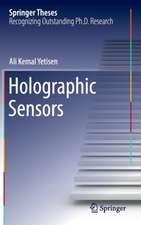Catalysis and Zeolites: Fundamentals and Applications
Editat de Jens Weitkamp, Lothar Puppeen Limba Engleză Hardback – 31 mai 1999
| Toate formatele și edițiile | Preț | Express |
|---|---|---|
| Paperback (1) | 1829.36 lei 6-8 săpt. | |
| Springer Berlin, Heidelberg – 30 noi 2010 | 1829.36 lei 6-8 săpt. | |
| Hardback (1) | 1835.83 lei 6-8 săpt. | |
| Springer Berlin, Heidelberg – 31 mai 1999 | 1835.83 lei 6-8 săpt. |
Preț: 1835.83 lei
Preț vechi: 2238.82 lei
-18% Nou
Puncte Express: 2754
Preț estimativ în valută:
351.30€ • 368.46$ • 292.44£
351.30€ • 368.46$ • 292.44£
Carte tipărită la comandă
Livrare economică 01-15 aprilie
Preluare comenzi: 021 569.72.76
Specificații
ISBN-13: 9783540636502
ISBN-10: 3540636501
Pagini: 588
Ilustrații: XVIII, 564 p.
Dimensiuni: 155 x 235 x 37 mm
Greutate: 0.99 kg
Ediția:1999
Editura: Springer Berlin, Heidelberg
Colecția Springer
Locul publicării:Berlin, Heidelberg, Germany
ISBN-10: 3540636501
Pagini: 588
Ilustrații: XVIII, 564 p.
Dimensiuni: 155 x 235 x 37 mm
Greutate: 0.99 kg
Ediția:1999
Editura: Springer Berlin, Heidelberg
Colecția Springer
Locul publicării:Berlin, Heidelberg, Germany
Public țintă
Professional/practitionerDescriere
Zeolites occur in nature and have been known for almost 250 years as alumino silicate minerals. Examples are clinoptilolite, mordenite, offretite, ferrierite, erionite and chabazite. Today, most of these and many other zeolites are of great interest in heterogeneous catalysis, yet their naturally occurring forms are of limited value as catalysts because nature has not optimized their properties for catalytic applications and the naturally occurring zeolites almost always contain undesired impurity phases. It was only with the advent of synthetic zeolites in the period from about 1948 to 1959 (thanks to the pioneering work of R. M. Barrer and R. M. Milton) that this class of porous materials began to playa role in catalysis. A landmark event was the introduction of synthetic faujasites (zeolite X at first, zeolite Y slightly later) as catalysts in fluid catalytic cracking (FCC) of heavy petroleum distillates in 1962, one of the most important chemical processes with a worldwide capacity of the order of 500 million t/a. Compared to the previously used amorphous silica-alumina catalysts, the zeolites were not only orders of magnitude more active, which enabled drastic process engineering improvements to be made, but they also brought about a significant increase in the yield of the target product, viz. motor gasoline. With the huge FCC capacity worldwide, the added value of this yield enhancement is of the order of 10 billion US $ per year.
Cuprins
J.-L. Guth and H. Kessler: Synthesis of Aluminosilicate Zeolites and Related Silica-Based Materials.- J.A. Martens and P.A. Jacobs: Phosphate-Based Zeolites and Molecular Sieves.- G.H. Kühl: Modification of Zeolites.- H.G. Karge, M. Hunger and H.K. Beyer: Characterization of Zeolites: Infrared and Nuclear Magnetic Resonance Spectroscopy and X-Ray Diffraction.- J. Weitkamp, S. Ernst and L. Puppe: Shape-Selective Catalysis in Zeolites.- P. Espeel, R. Parton, H. Toufar, J. Martens, W. Hölderich, and P. Jacobs: Zeolite Effects in Organic Catalysis.- P.M.M. Blauwhoff, J.W. Gosselink, E.P. Kieffer, S.T. Sie, and W.H.J. Stork: Zeolites as Catalysts in Industrial Processes.
Textul de pe ultima copertă
Zeolites and zeolite-like microporous materials have been playing an ever-increasing role in heterogeneous catalysis for more than three decades. An impressive number of large-scale industrial processes in petroleum refining, petrochemistry and the manufacture of organic chemicals are nowadays carried out using zeolite catalysts, and the future of zeolites in industrial catalysis continues to be bright. Authored by an international team of renowned scientists, the seven chapters of this book present a comprehensive overview of the application of zeolites in industrial catalysis, while also providing a true scientific understanding of how zeolites are synthesized, modified and characterized, and providing special emphasis on shape-selective catalysis, which is a unique feature of zeolites.
Caracteristici
Excellent cross-section of the fundamentals of zeolite science and their application in catalysis
Written by experts from both the university and the industry
Includes supplementary material: sn.pub/extras
Written by experts from both the university and the industry
Includes supplementary material: sn.pub/extras













